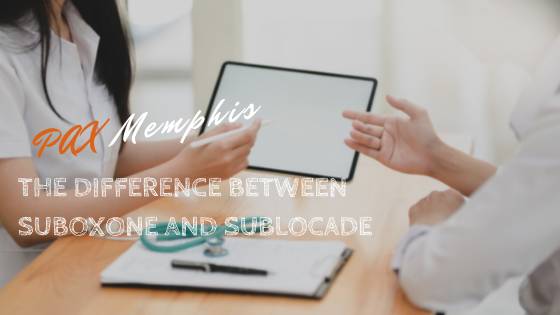Suboxone and Sublocade are two prescription medications used during medication-assisted treatment for opioid addiction. While they have similar results, it’s important to know the differences between the two drugs when choosing which medication to use during your treatment. Both medications must be prescribed by a doctor. When used as prescribed, the medications have great success in helping people to get sober and stay sober.
Sublocade and Suboxone treatment help reduce cravings and withdrawal symptoms in people recovering from opioid abuse. However, each medication has different methods of administration as well as very different dosing. Depending on your lifestyle, you may find one medication more convenient to use over the other.
Medication-Assisted Treatment for Opiate Abuse
Medication-assisted treatment (MAT) utilizes prescription medication in addition to evidence-based therapy in order to effectively treat substance use disorder. [1] It includes behavioral and cognitive therapy to treat the underlying causes of addiction. The benefit of using medications during opioid addiction treatment is that provides a more holistic approach. This means both the mind and the body are receiving care through the combination of therapy and medications.
MAT allows people suffering from opiate addiction to received more individualized care that is made to fit their unique needs. Tailoring a person’s program to their lifestyle makes it more likely they will follow the designated treatment plan. This promotes a higher adherence to the plan of care and reduces the risk of relapse in the long term. There are some different options when choosing a medication for MAT, the most popular ones being Suboxone and Sublocade.
What is Sublocade?
Sublocade is the newer of the two medications as was just recently approved in 2017. The active ingredient in Sublocade is buprenorphine. [2] Buprenorphine is a partial opiate agonist, meaning it only partially activates opiate receptors in the brain. [3] Commonly abused opiates such as heroin, oxycodone, and morphine are full opioid agonists. Full opioid agonists fully activate the opiate receptors, which subsequently produces feelings of euphoria, relaxation, and reduced pain.
When opiate receptors are only activated partially, it serves to reduce cravings and eliminate withdrawal symptoms without the side effects of euphoria and pain relief. This makes medications such as Sublocade much less addictive because all of the pleasant side effects are taken away.
What is Suboxone?
Suboxone, like Sublocade, also contains buprenorphine to reduce opioid drug cravings and withdrawal symptoms. However, it also contains an additional active ingredient called naloxone. Naloxone is a medication that is used to reverse opiate overdoses.[4] It works by directly binding to opiate receptors, which prevents any opiates from binding them. This means if a person was to relapse while on suboxone, it would prevent them from getting high off the drugs and also prevent a potentially fatal overdose.
Key Differences Between Sublocade and Suboxone
The differences between Sublocade and Suboxone are more complicated than just what active ingredients the medications change. They are administered through very different means, on different schedules, and at different dosages.
Methods of Administration
Sublocade is given as a subcutaneous injection. It must be given in a medical office by a physician.[2] The injection is only needed once a month. This is a great option for someone who has difficulty remembering to take medication daily or has abused Suboxone in the past. However, because the medication is long-lasting, a person needs to demonstrate that they can tolerate it. As a result, they will need to take a medication with buprenorphine daily for one week before starting treatment with Sublocade to ensure they don’t have any adverse side effects.
Suboxone is given as a daily dose. It is administered once daily as a sublingual film that dissolves under the tongue.[2] The benefit of this method of administration is that it is either self-administered or given by a physician. Depending on an individual’s lifestyle, they may find it more convenient to only have to take a medication once a month at their doctor’s office or take medication daily from the comfort of their own home.
Seeking Treatment for Opiate Abuse
If you or a loved one is suffering from opiate addiction it is important to seek treatment as soon as possible. Opioid addiction is fatal and more than 130 people die each day from an opioid-related overdose. The sooner you get help, the better.
At our drug and alcohol treatment center in Memphis, TN, we offer inpatient programs for opioid abuse that include medication-assisted treatment and comprehensive behavioral and cognitive therapy. With therapy and the help of medication to reduce the discomfort of opiate withdrawals and cravings, you will soon be on the road to sobriety. Our doctors and licensed addiction counselors will work closely with you to choose the medication and treatment plan that is right for you. Contact us today to learn more about our Sublocade and Suboxone treatment programs in Memphis.
- https://www.ncbi.nlm.nih.gov/books/NBK64168/
- https://www.drugs.com/medical-answers/difference-between-sublocade-suboxone-3535227/#:~:text=But%20there%20are%20differences%20between,you%20put%20under%20your%20tongue
- https://www.naabt.org/faq_answers.cfm?ID=2
- https://www.drugabuse.gov/drug-topics/opioids/opioid-overdose-reversal-naloxone-narcan-evzio
Medically Reviewed: September 25, 2019

All of the information on this page has been reviewed and verified by a certified addiction professional.










